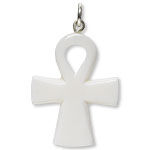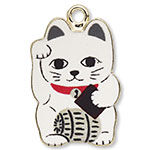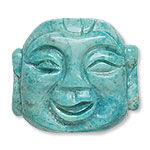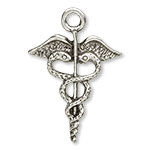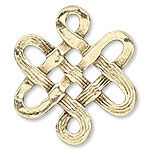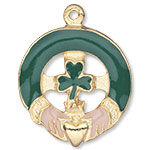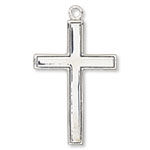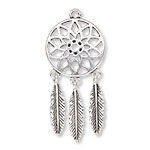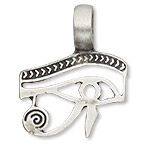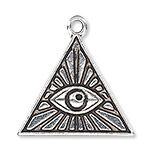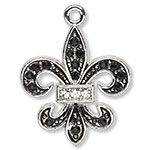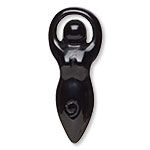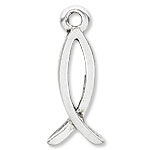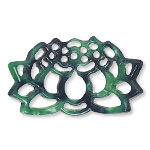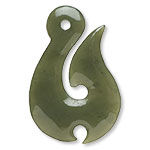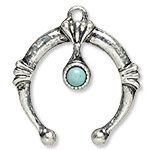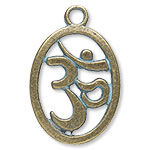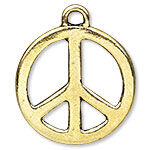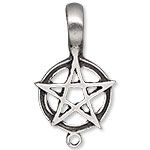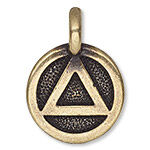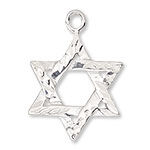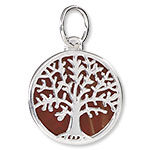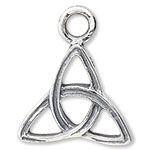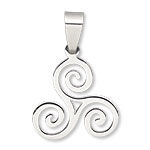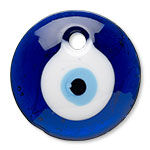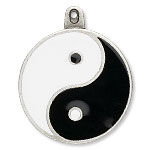Cultural Symbols in Jewelry
Incorporating cultural symbols in jewelry is not a new concept, though it has seen a boost in recent popularity. Interested in common religious, cultural or other iconography to include in designs? Learn meanings and design information, including which are used in weddings, to make meaningful designs for yourself or your customers.
The ankh, also called breath of life, key of the Nile or ''handled cross,'' is the most familiar Egyptian hieroglyphic. The character stood for life, and more specifically eternal life. The symbol has been seen with extra decoration in the form of other hieroglyphics, scarabs and wings (relating to the goddess Isis or god Horus). Egyptian deities were occasionally depicted holding an ankh by the loop. Ankhs were sometimes worn as talismans promoting longevity.
This symbol is popular for rings, necklaces (simple pendant or large collar styles), earrings and bracelets including upper arm bracelets reminiscent of Egyptian fashion. Other popular Egyptian-themed symbols sometimes incorporated with ankhs include the wedjat eye, pyramids, snakes or cartouche-like ovals. Alternative jewelry styles have used ankhs in styles with jagged or dagger-like ends and sentimental jewelry has been known to turn the loop into a heart as a symbol for eternal love.
These adorable kitties are called Maneki Neko though they are often referred to as beckoning cats or lucky cats. Coming from Japan, these cats are put in store windows, restaurants, homes, cars, jewelry and more. Legend has it a woman was so poor she had to sell her cat. The cat then came to her in a dream telling her to make a statue of the cat and sell it. The woman did so and became wealthy. Maneki Neko come in all shapes and sizes and inspires happiness. Traditionally, if the right paw is up the cat will bring good fortune, while the left paw up brings wealth. Both paws up was not a common original depiction, but is prevalent today, perhaps hoping to bring both types of fortune.
Cats are not uncommon in jewelry, and the Maneki Neko fits right in, especially when incorporated with other feel-good imagery, good luck charms and coins. These cats do not have to be a certain color, size or of similar decoration. Sometimes there are Japanese letters on the cat, some have collars or bibs, others are brightly colored. Especially perfect for cat lovers' jewelry, felines have been appreciated in many cultures throughout history including the Japanese, Egyptians and more. It seems the trend isn't slowing down.
Meaning ''awakened one'' or ''enlightened one,'' Buddha was a man famous for his intellectual journey to find the meaning of happiness. He renounced princehood and left to study with top religious teachers, adopting a life of asceticism before becoming enlightened. Buddha was said to discover Dharma, which is a belief in moderation: avoiding self-indulgence or self-mortification. It was the goal of those seeking the Four Noble Truths to achieve a state of nirvana free from ignorance, greed, hatred or defilements. Thin Buddhas are modeled after the original Siddhartha, while the Laughing Buddha came from China and is actually Hotei. Hotei is an image based off a Chinese Zen monk named Budai who is typically depicted as jolly and associated with generosity. Many people rub his belly for luck. It is assumed these two images became synonymous due to the similarity in name, both were Buddhists and according to legend Budai revealed himself as an incarnation of Maitreya Buddha (a future transcendent Buddha) before he died.
In jewelry, Laughing Buddhas are often incorporated with other Chinese symbols. The lotus is also typically seen as it is an integral part of Buddhist symbology. You don't need to be Buddhist to appreciate the connotations of acceptance, love and goodwill. For this reason, images of Buddha have been included in jewelry with other religion's symbols such as Om or hamsa hands, tree of life images and peace signs. Gemstones are a popular material to include.
The traditional symbol of the Greek god Hermes, the Caduceus is a winged staff with two snakes intertwined around it. Hermes was the conductor of the dead and protector of merchants. The Caduceus was also an ancient astrological symbol of commerce. Physicians adopted this symbol most likely due to its similarity in design to the staff of Asclepius, which is a staff with a single serpent wound around it. Both of these symbols have come to be associated with healing and medicine, often painted on ambulances or present in hospitals. One theory as to why a snake was the original depiction was due to a common parasitic worm infection in ancient times. This type of worm was compared to a snake. To remove the worm the skin was cut in front of its path and a rod was placed against the wound for the worm to extricate itself by winding around the rod.
The Caduceus is often found on medical alert tags. Medical jewelry has been seen decorated in recent trends to provide function and fashion. Often used as a pendant as well, it is common to see a faceted gem above the wings. Given as a symbol to promote health and longevity, the Caduceus has been paired with hearts or symbols of healing such as some Celtic knots.
Celtic knots are widely recognized symbols and were often used to exemplify interconnectedness or timelessness since they have no visible beginning or end. These symbols were valued as charms against setbacks in life. Sometimes Celtic knots were used as gifts to wish the recipient longevity. Celtic knots are sometimes incorporated into artwork with hearts or other Celtic symbols such as trinity knots.
Connotations range from robust to lyrical, imbuing Celtic knots with popularity in both male and female jewelry. It is not uncommon to see Celtic knots paired with green color schemes for culturally inspired St. Patrick's Day jewelry. Celtic knots have been used to add decoration to other shapes including basic geometric figures. Other utilitarian-type findings such as bails, head pins and ear wires are adorned with varying Celtic knots, so functional becomes fashionable and an added design element.
The Claddagh is a traditional Celtic symbol depicting two hands holding a heart topped with a crown. The hands are used to represent friendship, the heart equates to love and the crown stands for loyalty. More than friendship, the Claddagh has been used for displaying familial togetherness, as well as an indication of relationship, especially if found on a ring. If worn on the right hand with the heart facing toward the wearer's body, the person is in a relationship. If worn on the left hand ring finger and the heart faces away from the wearer, this indicates an engagement. When the heart is flipped facing toward the wearer while on the left hand ring finger, the person is married. ''With my hands, I give you my heart and crown it with my love,'' and, ''Let love and friendship reign forever,'' are phrases associated with this symbol.
Claddagh symbols are ideal to gift and wear as tokens of friendship whether on a ring, as a pendant or other jewelry. Lovers often exchange these symbols as well, making them ideal birthday, engagement, Valentine's and other occasion gifts. Jewelry featuring a Claddagh is sometimes used in conjunction with other Irish symbols, most notably the Celtic cross and three leaf clovers called shamrocks.
There have been a multitude of crosses throughout history, though the most common association is with the Christian faith. Jesus Christ was crucified on a cross and the structure became a symbol of the reconciliation of sins. The cross is a symbol of salvation and atonement. Though since the act of crucifixion was gruesome, the symbol was not widely worn until the second century. It was believed wearing a cross helped protect against misfortune or demonic forces. Crosses were symbols pre-Christianity as well. Crosses have been representations of the four elements fire, water, earth and air as well as directional north, south, east and west. Other cultures had similarly shaped symbols sometimes generically referred to as a cross.
Jewelry depicting crosses have been worn as a sign of faith and are often gifted by friends, family or loved ones. Crosses have also been used in alternative fashion cultures including biker, punk or Goth. Pendant necklaces and rosaries were the original ways to wear crosses, though the image is found in all forms of jewelry today. Crosses are popular additions to wedding jewelry. Other common shapes sometimes used in conjunction with crosses include hearts, flowers and birds (doves).
According to Native American folklore, the dream catcher is designed to snare negative dreams in the webbing while allowing good dreams to glide down the feathers to be had by the person sleeping below. The bad dreams are said to die at daybreak. Dream catchers were first made using willow formed into a hoop. The decorations could be feathers, arrowheads, beads and more. Iktomi appeared to a spiritual leader in the form of a spider and wove the first dream catcher. Upon finishing the piece, Iktomi instructed the leader to share it to help the people reach their goals and make good use of their visions and dreams.
Dream catchers in jewelry can resemble authentic dream catchers with natural materials, or are created with jewelry cord and wire. Dream catchers promote good thoughts, since the design is supposed to keep bad forces from entering our thoughts and dreams. The webbing of dream catchers is often decorated with turquoise and seed beads, though these are not a designer's only options. Dream catchers are popular as earrings since they can be big while remaining lightweight.
This Egyptian symbol is also referred to as the Wedjat eye, since it was associated with the goddess Wadjet (including various other spellings) as well as Horus. Horus is the ancient Egyptian sky god was who was typically depicted as a falcon. The eye of Horus was a symbol of protection, royal power and good health. Each part of the eye design has a specific meaning, converging to represent the six senses. The front corner of the eye resembles a nose and is associated with smell, the pupil is sight, the eyebrow represents thought, the left half of the eye is hearing and points to the ear, the curved tail beneath is said to represent taste and the straight line down from the eye is touch--like a leg grounding the symbol.
For jewelry, the eye of Horus is often used alongside other Egyptian symbols such as the ankh or scarab. Oftentimes designers will choose to color the eye or even replace the pupil with a gemstone or crystal bead. The eye of Horus is popular in specifically Egyptian-inspired jewelry designs as pendants, rings and more, but has also been depicted in alternative jewelry and clothing styles.
Also called the all-seeing eye of God, the Eye of Providence is depicted as an eye often surrounded by rays of light or a glory and enclosed in a triangle. A glory is an optical phenomenon also called an anti-corona or pilot's bow that resembles the iconic halo above Saints' heads. This symbol represents divine providence or how God watches over mankind. Perhaps one of the most well-known uses of this symbol is on the Great Seal of the United States, which appears on the one dollar bill. The Eye of Providence often holds religious significance. In the Christian faith, the design can represent the Holy Trinity, in Buddhism the symbol can be referred to as the Eye of the World and in Hinduism the eye is sometimes referred to as the third eye of Lord Shiva. Some people have come to view the eye as less benign and associated with the Illuminati.
With so many connotations, it's no wonder this symbol appears in jewelry alongside numerous others. Emphasize religious connotations by including charms of other symbols such as the lotus flower or Om symbol. Gift the all-seeing eye as a pendant necklace or add to a bracelet design as a way to let friends and loved ones know they have a watchful eye to look after them.
Coming from the Old French "flour de lys" or "flower of the lily" a Fleur-de-lis is a stylized lily with three petals bound near the base. There is speculation the French monarchy adopted the Fleur-de-lis as their royal coat of arms to be a symbol of saintly purity. Similarly, the Roman Catholic Church associated the lily with the Virgin Mary. Since there are three petals, there have been interpretations of the holy trinity in Christian-based faiths. Military units have included fleur-de-lis symbols as a sign of power and strength. Modern celebrations of mardi gras often see countless decorations of Fleur-de-lis on clothing, jewelry and more.
With such a diverse group of associations, the jewelry potential is similarly vast. It is a graceful flower, lending its image well to female jewelry, though it has a royal strength allowing the symbol to be used in men's designs as well. The New Orleans Saints sports team also uses it as their team's design and the South is often associated with this symbol. Fleur-de-lis may be turned up or down and have been found incorporated with crosses, keys and coats of arms.
The goddess symbol embodies all things feminine, representing female power and strength. The ancient goddess is commonly associated with love and fertility and includes themes of beauty, love, sexuality and fertility, motherhood and creativity. The triple moon goddess (with waxing, full and waning moon) is also associated with feminine energy.
As an ancient and beloved symbol, the goddess always holds a positive role. She is the giver and creator of all life, overseeing the growth of children and the earth, and her presence is perfect for expecting moms.
A Hamsa hand is also known as the hand of Fatima, hand of Miriam or the eye of Fatima. The hand is open and an eye is embedded in the open palm. The hand can be natural or symmetrical with a thumb replacing the pinky. In Islam, Fatima references Mohammed's daughter while in Judaism, Miriam is Moses' sister. Hamsa is said to originate from the Hebrew word "hamesh," directly translating to ''five.'' For both religions, the hand is said to be a talisman against harm such as the evil eye (five is often associated with fighting the evil eye) and promotes fertility, luck or health. The five fingers can represent the five sacred rules of beliefs or pillars of Islam.
These hands are depicted with the fingers pointing up or down and are often used in conjunction with other religious symbols such as crosses, the Om symbol, Buddhist imagery, the tree of life and more. Eastern-inspired designs commonly depict a Hamsa hand. Since the hand is considered protective, it is an excellent gift whether on a necklace, bracelet or other form of jewelry, and has been included on key chains, home decor and more. Sometimes the eye is covered or replaced by florals, a swirl or filigree details for a delicate, feminine touch and the hand has been known to be embellished with crystal, gemstone or enamel for a colorful take.
The Ichthys fish is also known as ichthus, Christian fish or Jesus fish. Fish are referenced multiple times in the Christian Bible including the story of Jonah, the feeding of five thousand with two fish and five bread loaves, Jesus instructing his disciples to cast their nets on the opposite side of the boat, calling for believers to be ''fishers of men'' and more. It is also speculated during the time of Christian persecution by the Roman Empire, Christians used this fish symbol to mark meeting places and identify friends. The word itself is an acronym translating to ''Jesus Christ, Son of God, Savior.'' Iota (I) is the first letter in the Greek spelling of ''Jesus.'' Chi (ch) is the first letter of "anointed" in Greek. Theta (th) is the first letter of ''God's'' in Greek. Upsilon (y) is the first letter of ''Son'' in Greek. And, Sigma (s) is the first letter of the word for ''Savior'' in Greek.
In jewelry, the Ichthys fish is used similarly to crosses. Faith-based jewelry of all kinds, including earrings, pendant necklaces and more, display the Christian fish. Sometimes the fish has a design on the inside such as an eye, a cross or "JESUS." The Ichthys is sometimes used in conjunction with other symbols of faith such as doves, hearts and flowers. Ichthys fish are also popular for use in Easter or Christmas jewelry.
The Lotus flower is considered a symbol of purity in Buddhism, and one of beauty in Hinduism. The heart of man is compared to an unopened lotus and once an individual reaches enlightenment, the Lotus blooms. For this reason it is not uncommon to see a statue of Buddha upon a Lotus flower. Since Lotus flowers grow in a ''dirty'' environment of mud, the Lotus is often used in metaphors of seeking truth and happiness without being blemished by the world. Confucius put it best, ''I have a love for the Lotus, while growing in mud it still remains unstained.'' In Hinduism, the Lotus flower is associated with one of the three principle deities, Vishnu. It was a Lotus that bloomed from Vishnu's naval bringing Brahma to create the world.
Lotus flowers are often paired with other religious symbols including images of Buddha, the Om symbol and more. Lotus flowers are often associated with femininity and can be accompanied in designs by other flowers. Each color of Lotus flower also has specific characteristics. White represents passive nature and perfection. Red symbolizes the heart, giving it the characteristics of love and passion. Blue represents the spirit's victory over senses and is typically represented as a partially open bloom. Pink is considered the supreme color and reserved for the highest gods. Purple is sometimes depicted, though not natural, and is considered mystical.
The Makau, also known as the fishhook, carries profound symbolism across Hawaii and Polynesia. It represents safe passage over water, luck and strength, embodying the deep connection between the islanders and the sea. Traditionally crafted from natural materials like bone, wood, coral or stone, it is a symbol of reliance on the ocean for sustenance.
While the Makau maintains its traditional roots with carvings from organic materials, contemporary artisans are embracing upscale mediums like jade, turquoise and other gemstones, adding a modern twist to this ancient emblem of resilience and reverence.
The naja (Navajo word for "crescent") is an upside-down moon shape that is popular in southerwestern-inspired jewelry and appears as the centerpiece of Native American squash blossom necklaces. Images of the naja have been around since the Paleolithic era and were particularly seen as Moorish. The Spanish used the shape as a bridle ornament and saw it as a protective symbol for the horse and rider. The conquistadors brought these bridle ornaments with them when they came to the Americas, and the squash blossom began to see creation in the hands of Navajo silversmiths--though the design was also used by other tribes.
The naja is a symbol of protection in most of its original iterations. Najas were originally only silver, but after the late 1800s, lapidary techniques were applied to include gemstones such as turquoise or even coral. The naja can also be associated with birth. If a turquoise bead is included or dangling from the center of the naja it may be represent a child in the womb. In general, the squash blossom did not have ceremonial purpose, but was worn as a status of wealth or cultural association.
The Om symbol, also spelled Aum, is a primary concept in Hinduism representing the cosmic beginning of creation. The syllable Om is a tone and vibration said to be the basis for all mantras. Mantras are repeated sounds or words designed to help a person meditate and focus. This sacred symbol is the essence of all the Vedas, which originated in India, and are the oldest texts of Sanskrit literature and Hindu scripture.
In jewelry, the Om symbol is often seen in conjunction with lotus flowers and mandalas or other religious symbols including the hand of Fatima. Due to its relaxing connotation, the Om symbol is also popular to pair with peace signs. When worn as earrings, a pendant or on a bracelet, the Om symbol can be a reminder to the wearer to breathe and maintain peace in their mind, body and spirit.
The peace sign has become an internationally recognized symbol of peace and acceptance since its creation by British artist, Gerald Holtom in 1958. The symbol design represents the navy signaling letters N and D standing for Nuclear and Disarmament. Since the symbol was anti-militaristic, the D is placed on top of the N so as to read backwards. First used at a Direct Action Committee Against Nuclear War march, the symbol was placed on protest signs, made into lollipops and more. In the 1960s the symbol came to the USA and was adopted as a peace movement symbol promoting free love and non-violence. The symbol made appearances in civil rights marches at the time of Martin Luther King Jr., in South Africa under apartheid regime and during anti-Vietnam war protests.
Not just for hippies, peace signs are about accepting our fellow man no matter their race, creed, religion and more. While anti-militaristic movements also sport peace signs, it is not the only interpretation. Peace signs are often found in jewelry as design centerpieces themselves or with other peace-inspired symbols such as hearts, doves, rainbows, the ''V'' hand gesture and more. Flowers are also common, no doubt inspired by the flower children of the 1970s.
The five-pointed star, sometimes in a circle, has had potent connotations throughout its existence, and some of them not always accurate. The pentagram has shown up in many ancient civilizations including those in Latin America, India, China, Greece and Egypt. Often the symbol had astronomical meanings such as the five visible planets or the path of Venus. Other interpretations included the symbol as one of man. According to the famous Greek mathematician Pythagoras, five was the number of man (the shape our bodies make when hands and feet are spread as well as our five senses) and could represent the five elements fire, water, air, earth and psyche. This may have also stemmed from the goddess of healing, Hygeia, who's name was an anagram for the elements of water, earth, spirit, fire and air in Greek. Christians also appreciated the pentagram, viewing it as proof of divinity. Since the star formation could be interpreted as man, it symbolized God manifesting in the flesh and could also represent the five wounds of Jesus during his crucifixion. The pentagram was sometimes believed to protect against evil when worn.
Incorporating this five-pointed star in jewelry can add extra meaning or an ancient feel. When placed with other cultural symbols such as the Greek key, pentagrams bring to mind the Greek interpretations. Or include the Hamsa hand for increased India symbolism. Pentagrams are also celestial, perfect for incorporating with moons and other heavenly bodies. The star does not have to be oriented in a certain way, and turning it upside down does not automatically indicate something sinister.
This equilateral triangle inside a circle is also known as the Sobriety Circle and Triangle Symbol. The design is used by the group Alcoholics Anonymous. The triangle represents the three parts of addiction (physical, mental and spiritual) as well as the three parts to the cure (unity, recovery and service). The circle that surrounds these concepts represents wholeness or oneness and combines the elements into one. Before AA adopted this symbol however, the design was long used by native cultures. Medicine men and priests regarded the circle enclosing a triangle as a means of warding off evil spirits.
Jewelry that uses the recovery symbol gives hope for mental health and addiction recovery. Recovery symbol jewelry can be as simple as a pendant on chain or can include other relevant symbols such as awareness ribbons. The most commonly paired ribbon colors are light blue (addiction recovery) and red (alcohol awareness). A metal blank is sometimes strung to hang behind the recovery symbol and is stamped with the date when an individual began sobriety. Other symbols sometimes included with the recovery symbol in jewelry designs include hearts, the "evil eye," religious symbols like crosses that remind us to have faith and symbols that remind individuals to relax such as the Om.
The Star of David--the Magen David, Seal of Solomon or shield of David--has come to be associated with Judaism, though it was not originally an exclusive Jewish symbol. The two intertwined equilateral triangles were also a common symbol in the Middle East and northern Africa used to bring good luck. It was not until Jews wore these stars as identification of their heritage during Nazi occupation did the star-like shape stand out as a symbol of Judaism. By the 17th century synagogues often had the Star of David on the outside as an identification of a house of worship.
A symbol of solidarity amongst the Jewish people, the Star of David packs a powerful religious or cultural punch in modern jewelry. It is not uncommon to see the Star of David used in conjunction with traditional Jewish symbols such as the menorah, Lion of Judah and the 10 Commandments tablets. Jewish athletes have also sewn or worn the Star of David on their uniforms.
Depicted in numerous cultures, the tree of life often represented a connection of the three worlds: heaven, earth and the underworld. For Christians, a tree sat at the center of Eden. The Norse had Yggdrasil and the Mayans had Yaxche with the utmost branches supporting the home of their respective gods. To the Egyptians the tree was a holy sycamore connecting the concepts of life and death. Trees have been used to depict death and rebirth due to the cycle of winter bareness and spring blossom. Trees have been depicted not only as homes for deities, but also as gods themselves such as the Sumerian god Dammuzi and Hindu Brahman. Trees have connotations of life-giving qualities, especially fruit-bearing varieties. Aside from religious connotations, the tree of life is often interpreted as a rooting in the here and now; a solid foundation to reaching or striving from, branching out to learn and grow as an individual. Also a symbol of family, the branches represent the growing family and remaining connected to each other.
As a symbol of nature, the tree of life is easy to incorporate in jewelry. The tree of life is often depicted with other natural shapes such as butterflies, leaves, birds and more. Incorporating other symbols from specific geographical locations calls forth the cultural interpretations of the region. The tree of life is also commonly created from wire surrounded by a circle and decorated with crystal or gemstone chips as the leaves.
While many people place trinity knots, also called triquetras, in the same realm as Celtic knots, the designs do have some fundamental differences. Trinity knots always have three distinct points. Three is considered a powerful number in many cultures and trinity knots are sometimes interpreted as a protective symbol or one of promises. The triangular-like formation was used in ancient Celtic, Nordic, Germanic and other paganistic artwork as well as in Christian symbology equating to the holy trinity of the Father, son and holy ghost.
Trinity knots are found in the same types of jewelry as the previous Celtic symbols including culturally inspired, religious or talismanic designs. Since trinity knots are often believed to represent love, honor and protection, the symbol can be found incorporated with Claddagh or other wedding-type jewelry. When not in engagement jewelry, it is often fun for the designer or wearer to determine their own interpretation of the triple points.
The triskele is a complex, ancient symbol with three ''legs'' seemingly in motion and is most often associated with progress, action and cyclic motion. The three legs have been given varying meanings depending on the particular culture and era the symbol was found. Interpretations include a religious trinity; familial bonds of a mother, father and child; the past, present and future; the continuum of creation, existence and destruction; the spiritual, mortal and celestial worlds; etc.
This type of diverse symbol is ideal for jewelry since the designer or wearer can impart personal connotation. Created for or gifted to a family member, the triskele can represent familial connection. Placed with other religious symbols, it represents the holy trinity and works well alongside Celtic or other crosses. Select as an ideal gift for graduates since the triskele represents progress, or if starting a new chapter in one's life the symbol reaffirms positive action.
The concept of the evil eye exists in almost every culture including Ancient Greece, the Middle East, Europe, Central America and more. The evil eye is a glance or ill wish towards an individual. The evil eyes are thought to cause harm or bad luck, as well as physical or mental illness. Jealousy or excessive praise resulting in swollen pride endangers an individual to the effects of the evil eye. To counteract the curse, talismans depicting eyes were worn or carried. Indigo blue is a common color for these eyes as the color was believed by the Greeks to hold power. These evil eye talismans deflect harm from the wearer.
The most common depiction is a circle with painted concentric circles in varying colors to represent an eye. Pointed oval shapes with a circle in the middle have also been interpreted as a design of warding off the evil eye, giving jewelry designers options when designing. Celebrities such as Cameron Diaz, Brad Pitt, Rhianna and more have been spotted wearing evil eye amulets on necklaces and bracelets.
While Western culture refers to the symbol as Yin-Yang, the true name is Taijitu. A fundamental Chinese concept, the Yin-Yang symbol represents duality. The two separate concepts Yin and Yang represent opposite ideas, which when brought together complement and complete the whole. The whole is greater than the individual parts. Yin is associated with night, female and South while Yang is the sun, male and North. While this seems cut and dry, the idea of interconnectedness ensures the concepts associated with Yin and Yang are dependent upon each other and therefore not inherently absolute. The Yin-Yang symbol has come to be associated with Taoism.
In jewelry, Yin-Yang symbols are popular for both men and women. Clasps featuring Yin-Yang symbols are especially interesting since they are visual representations of the two concepts forming a whole. Black and white are the most typical colors for this symbol, no doubt since they are further visual aids in the explanation of opposites attracting, but designers are not limited to these. The symbol has also been created with blue (water) and red (fire) or other unique color combinations.
How did you like this resource? Your feedback helps us provide resources that matter to you most.
Copyright Permissions
All works of authorship (articles, videos, tutorials and other creative works) are from the Fire Mountain Gems and Beads® Collection, and permission to copy is granted for non-commercial educational purposes only. All other reproduction requires written permission. For more information, please email copyrightpermission@firemtn.com.

